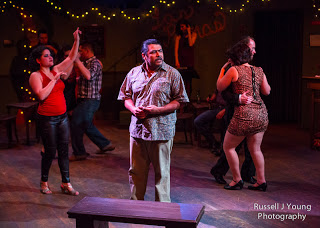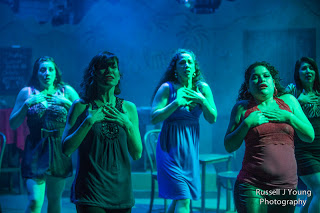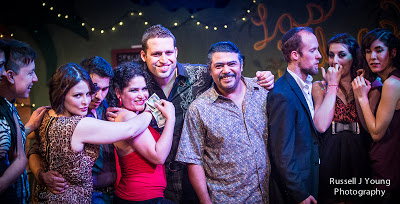 Of all things I imagined, this is not what I expected.
Of all things I imagined, this is not what I expected.
The opening weekend of “Dance for a Dollar” is barely over and I’m still amazed at everything we’ve experienced. By “we” I mean the actors, company staff and the participants in the on-going discussion built into the end of the performance.
That alone is a departure which, while not entirely alien, is new and exciting every night. I have done many events that include a question-and-answer period, or a panel discussion, or a “talk back” with the audience. We eventually settle into something like those, but our first exchanges with the audience begin as individual actors with one or two theater-goers, dropping our masks to connect in a more comfortable form of dialog. We may start talking about the play but really end up sharing experiences and emotions of basic but significant things like home, family, music.
The creator and director, Daniel Jáquez, mentioned that in the development of the more abstract movement sections, the participants in the workshops ended up presenting, on their own, a very similar body language as this cast did in our rehearsal process, without ever having seen or discussed what previous performers had done. This confirms for me the perhaps clichéd notion of the universality of art. And the audience’s reactions are yet another big affirming nod. A cliché becomes one by being too true.
The person I speak with or who participates in the discussion may be different night after night, but there are certain themes that invariably come up. The show, like this modern country, is mostly built around, by, and with immigrants (and in this cast, most of us who play one ARE one). Without fail, those who’ve seen the play relate it in a very personal way to friends or family, and what they encountered when they arrived from Germany, the Philippines, Central America, Mexico or wherever. There’s the sometimes ambivalent hankering for what’s left behind, but also the community they found or created when they reached their new home, whether temporary or permanent.
 Another recurring element is how that mixture of emotions and longing is expressed, heightened and/or soothed by the music, starting with the “esoteric” composition by Marios Aristopoulos. The nostalgic “Volver, volver” sometimes prompts audience members to let out that “glad cry” that is elemental in Mariachi music. The soulful “Macorina” as recorded by another immigrant, the incomparable Chavela Vargas, with its words of primal passion reminds us of healing touch and unforgettable love. Even the original pieces by Sinuhé Padilla-Isunza sound familiar and classic: someone who could have never heard “¡Echapalante!” insisted he had done so before.
Another recurring element is how that mixture of emotions and longing is expressed, heightened and/or soothed by the music, starting with the “esoteric” composition by Marios Aristopoulos. The nostalgic “Volver, volver” sometimes prompts audience members to let out that “glad cry” that is elemental in Mariachi music. The soulful “Macorina” as recorded by another immigrant, the incomparable Chavela Vargas, with its words of primal passion reminds us of healing touch and unforgettable love. Even the original pieces by Sinuhé Padilla-Isunza sound familiar and classic: someone who could have never heard “¡Echapalante!” insisted he had done so before.
Then there’s the physical element. Some people watching tap their toes, others say they want to leave the theater dancing; some even wish they could join us on stage. This is, of course, during the social and folkloric dances. The abstract movement pieces have been described as both unsettling in their expressiveness and surprisingly clarifying of the text. The moving words we speak are given a different dimension when the body rejoices or cries as well; that is dance and theater, but even more so of both, and it has led audience members to say they were not watching, they were feeling the performance. The word “visceral” or a synonym has been used repeatedly, and the lives of the characters (in turn based on the lives of very real people) have run through the bodies in the theater during that brief journey. When one woman said that it engaged all her senses except maybe smell, her husband reminded her that it also was touched.
Although we have already done it several times through previews and opening weekend, I know I will hear more audiences’ reactions that like the music will be at once familiar and new. It is amazingly fulfilling to be part of this brave new show, that has such feeling in’t.

